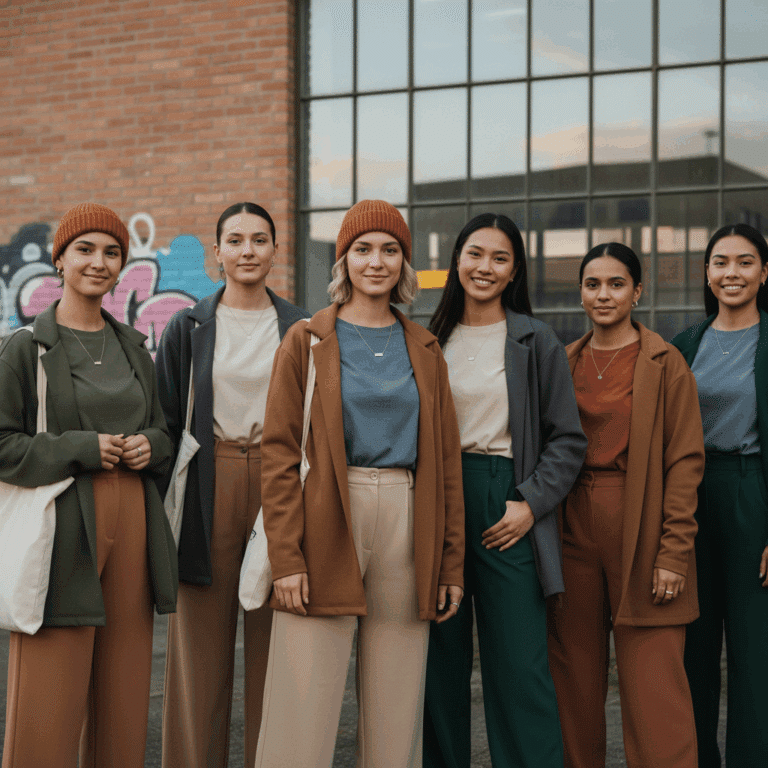Growth and Market Trends of Gender-Neutral Fashion
The rise of gender-neutral fashion is reshaping the apparel industry by breaking traditional male and female clothing distinctions. This shift is broadening market opportunities and reshaping consumer expectations.
With an estimated global market size of $3.2 billion in 2024 and steady growth forecasts, gender-neutral apparel is moving beyond niche status to become a key sector in fashion worldwide.
Global Market Size and Forecast
The global gender-neutral fashion market was valued at approximately $3.2 billion in 2024, reflecting strong demand for inclusive and versatile clothing options. Analysts project consistent growth over the coming years.
This expansion is driven by increased consumer interest in apparel that transcends binary gender categories, encouraging brands to develop collections emphasizing comfort and universal design.
Industry forecasts suggest sustained market growth as more companies integrate gender-neutral lines to appeal to diverse audiences worldwide.
Demographic Drivers: Gen Z and Millennials
Generations Z and Millennials are the main forces fueling the gender-neutral fashion trend, prioritizing authenticity, inclusion, and self-expression in their wardrobe choices.
These younger consumers reject rigid gender labels in clothing, favoring comfort and versatility that align with their evolving identities and values.
Research indicates that over one-third of North American shoppers have purchased clothing outside their assigned gender, with nearly 73% open to buying more gender-neutral apparel in the future.
Design and Consumer Behavior Shifts
Design in gender-neutral fashion focuses on comfort, versatility, and individual expression, moving away from traditional gender constraints. This shift enables consumers to choose garments that reflect their unique identity.
Consumers increasingly prefer pieces that are universally wearable and adaptable, fostering freedom in style that challenges conventional male and female categories in clothing.
Comfort, Versatility, and Individual Expression
Gender-neutral clothing prioritizes comfort with soft fabrics and flexible fits, appealing to a wide range of body types regardless of gender.
Versatility is key, as these garments often feature unisex cuts and styles suitable for different occasions, supporting consumers who value multifunctional wardrobes.
Importantly, it provides a platform for individual expression, encouraging wearers to break free from traditional gender norms and showcase personal style authentically.
Consumer Adoption and Openness to Unisex Clothing
Consumer adoption of gender-neutral fashion is accelerating, with many shoppers actively seeking unisex options to diversify their closets beyond gender binaries.
Studies show that a significant majority are open to exploring more gender-neutral pieces, indicating strong demand growth and cultural acceptance.
This openness reflects broader changes in society where inclusivity and fluidity in identity are embraced, influencing purchasing behaviors across age groups.
Impact on Physical and Online Retail Layouts
Retail environments are evolving as stores reconsider traditional layouts, moving from gender-segregated sections to organizing by style, function, or season.
Online platforms mirror this trend, offering filters and categories that promote shopping by lifestyle needs rather than strict gender distinctions, enhancing user experience.
These changes in retail design foster a more inclusive shopping atmosphere, appealing to a broader customer base and reflecting shifting consumer expectations.
Industry Adaptations and Brand Initiatives
The fashion industry is actively responding to the gender-neutral trend by launching unisex collections and reimagining marketing strategies. This transformation reflects a commitment to inclusivity and modern consumer values.
Brands are not only adjusting product designs but also innovating in their promotional approaches and runway presentations, increasing visibility and acceptance of gender-fluid fashion.
Major Brands’ Unisex Collections
Leading brands like Levi’s, Nike, Gucci, H&M, and ASOS have introduced gender-neutral collections, embracing fluidity in design to appeal to wider audiences. These offerings emphasize versatility and comfort.
These unisex lines challenge traditional gender norms by blending styles and fits, inviting all consumers to engage with fashion that aligns with their identity, rather than societal expectations.
Such collections often prioritize sustainability and functionality, reinforcing brand relevance while fostering loyalty among socially conscious and diverse customer bases.
Marketing and Runway Changes
Marketing campaigns are increasingly inclusive, showcasing models of varied gender identities and expressions to highlight the fluidity of modern fashion.
Runways now feature diverse castings and collections designed without gender borders, spotlighting creativity and breaking down historical barriers in fashion presentation.
Interesting Insight
Some brands have adopted gender-neutral fashion weeks or special events, promoting conversations about identity and inclusion while boosting industry innovation and consumer engagement.
This trend demonstrates growing industry awareness that embracing diversity is essential for cultural relevance and market growth in contemporary fashion.
Social and Business Implications
The rise of gender-neutral fashion enhances inclusion and visibility for non-binary and transgender communities, promoting acceptance through diverse representation in clothing.
Simultaneously, this shift offers distinct business advantages by expanding market reach and aligning with evolving consumer values on a global scale.
Inclusion and Visibility for Non-Binary and Trans Communities
Gender-neutral fashion provides a crucial platform for non-binary and trans individuals to express themselves authentically and feel represented within the fashion industry.
This visibility challenges traditional gender binaries, helping normalize diverse identities and supporting societal acceptance through inclusive apparel options.
Brands embracing unisex collections often engage directly with LGBTQ+ communities, fostering trust and reinforcing commitments to diversity and equality in fashion.
Business Advantages and Global Market Adoption
Adopting gender-neutral lines allows companies to broaden their customer base by appealing to consumers seeking versatile and inclusive clothing choices.
This approach reduces stock complexity and taps into emerging demand in markets like Sweden and the UK, where non-binary fashion is increasingly mainstream.
Ultimately, integrating gender-neutral fashion enhances brand relevance globally, strengthens customer loyalty, and drives innovation in a competitive industry.






